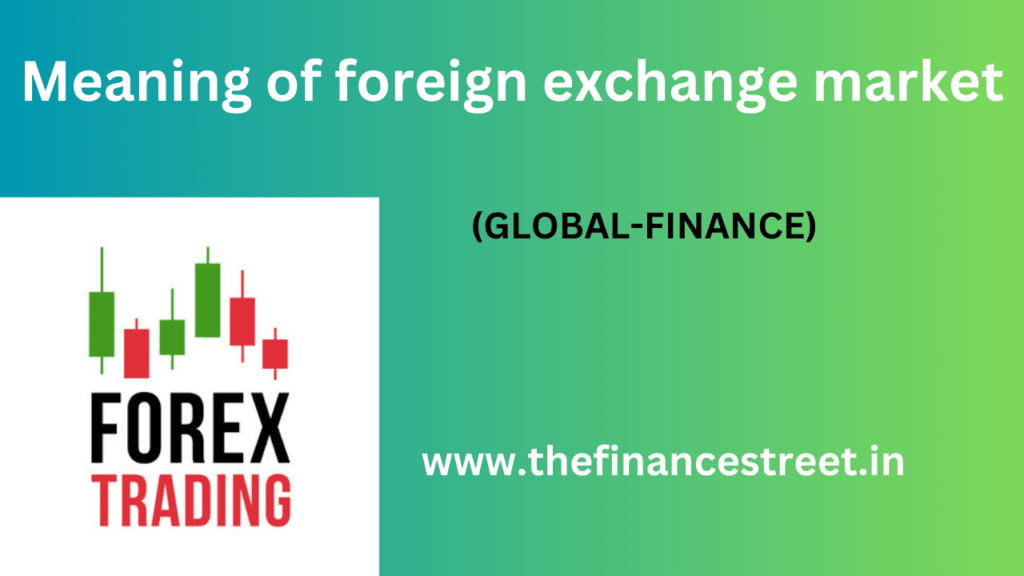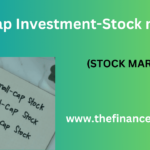Introduction for foreign exchange market-
The foreign exchange market, also known as forex or FX, is a decentralized global market where currencies are traded. It is the largest and most liquid financial market in the world, with an average daily trading volume of over $5 trillion.
The forex market operates 24 hours a day, five days a week, and it is open to anyone who wishes to participate. The main participants in the forex market include banks, governments, multinational corporations, and individual traders.
Currencies are traded in pairs, with one currency being bought and the other being sold. The value of a currency pair is determined by supply and demand, which is influenced by a variety of factors such as economic data releases, geopolitical events, and central bank policies.
The forex market offers traders the opportunity to profit from fluctuations in currency exchange rates. It also serves as a critical tool for businesses and governments to manage their international trade and investment activities.
Understanding the dynamics of the forex market is essential for anyone looking to participate in international trade or engage in currency trading.
What is the meaning of foreign exchange market?
The foreign exchange market, also known as the forex or FX market, is a global decentralized market where the world’s currencies are traded. It is the largest financial market in the world, with an average daily trading volume of over $5 trillion, and it operates 24 hours a day, five days a week.
The purpose of the foreign exchange market is to facilitate international trade and investment by allowing businesses, governments, and individuals to exchange one currency for another. For example, a company that imports goods from another country will need to pay for those goods in the currency of the exporting country, which requires exchanging its own currency for the foreign currency.
The foreign exchange market allows participants to buy, sell, and speculate on currency exchange rates. The value of a currency is determined by supply and demand, which is influenced by various economic, political, and social factors. Traders in the forex market can profit from changes in exchange rates by buying a currency when its value is low and selling it when its value increases.
Overall, the foreign exchange market plays a crucial role in the global economy by enabling international trade and investment and facilitating the movement of capital between countries.
What are the types of foreign exchange market?
There are primarily two types of foreign exchange market:
- Spot Market: This is the most common type of foreign exchange market where currencies are traded for immediate delivery. In the spot market, currencies are traded at the current market rate, which is known as the spot rate. This market operates 24 hours a day, five days a week, and is the most liquid market in the world.
- Forward Market: The forward market is a type of foreign exchange market where currencies are traded for future delivery at a predetermined exchange rate. In the forward market, buyers and sellers agree to exchange currencies at a specified date in the future at a fixed exchange rate. This market allows participants to hedge against currency risk by locking in exchange rates in advance.
- Apart from these two primary types of foreign exchange markets, there are also currency futures markets and currency options markets, which are essentially derivatives markets where traders can speculate on future movements in exchange rates or hedge against currency risk.
Overall, the different types of foreign exchange markets provide a variety of options for participants to manage their currency exposures, make international payments, and engage in currency trading activities.
What is foreign exchange market in India?
Foreign exchange market in India refers to the market where foreign currencies are bought and sold. The Indian foreign exchange market is regulated by the Reserve Bank of India (RBI) and operates under the Foreign Exchange Management Act (FEMA).
The Indian forex market is primarily made up of banks, financial institutions, and authorized dealers who are permitted to deal in foreign exchange transactions. Individuals and companies are also allowed to participate in the market subject to certain regulations and restrictions.
The Indian forex market consists of both the spot market and the forward market. The spot market in India operates through the interbank market, where banks and financial institutions trade currencies at the prevailing market rates. The forward market, on the other hand, allows participants to enter into contracts to buy or sell currencies at a future date at a predetermined exchange rate.
In addition to the spot and forward markets, the Indian forex market also has currency futures trading, which allows investors to trade in currency futures contracts on exchanges like the National Stock Exchange (NSE) and the Bombay Stock Exchange (BSE).
Overall, the Indian forex market plays an essential role in the Indian economy by facilitating international trade and investment and providing a platform for currency exchange transactions.
How of foreign exchange market works?
The foreign exchange market works through a network of financial institutions, such as banks, who act as intermediaries between buyers and sellers of currencies. The market operates 24 hours a day, five days a week, across different time zones, allowing participants to trade currencies in real-time.
The value of a currency is determined by supply and demand, which is influenced by various economic, political, and social factors. When there is high demand for a currency, its value increases, and when there is low demand, its value decreases.
The foreign exchange market allows participants to buy and sell currencies in the form of currency pairs. For example, if a trader wants to buy the Euro and sell the US Dollar, they would enter into a EUR/USD trade. The exchange rate between the two currencies is determined by the market, and the trader can profit from changes in the exchange rate by buying low and selling high or vice versa.
The forex market also allows participants to engage in speculative trading, where they buy or sell currencies with the intention of making a profit from changes in exchange rates. Speculative trading can involve a high degree of risk, as exchange rates can be highly volatile and unpredictable.
Overall, the foreign exchange market operates on the principles of supply and demand, allowing participants to trade currencies based on their expectations of future price movements. The market provides a critical mechanism for facilitating international trade and investment and managing currency risk.
What is the history of foreign exchange Market?
The history of foreign exchange (forex) market can be traced back to ancient times when traders exchanged goods and services across different regions and countries. However, the modern forex market as we know it today evolved over time, driven by advances in technology, globalization, and changes in the international monetary system.
One of the significant milestones in the history of forex market was the Bretton Woods agreement in 1944, which established the US dollar as the global reserve currency and pegged it to gold. This system created a fixed exchange rate system among major currencies, but it eventually collapsed in the 1970s, leading to the development of the floating exchange rate system.
The advent of electronic trading platforms and the growth of the internet in the 1990s revolutionized the forex market, making it more accessible and efficient. This enabled retail traders and smaller institutions to participate in the market, which was previously dominated by large banks and financial institutions.
Since then, the forex market has grown in size and complexity, with a daily turnover of over $5 trillion, making it the largest financial market in the world. The market is now characterized by high-speed electronic trading, algorithmic trading, and the use of complex financial instruments such as derivatives.
Overall, the history of the forex market reflects the evolution of international trade and finance, and the market will continue to evolve in response to changes in technology and the global economic landscape.
What is the structure of foreign exchange market-
The structure of the foreign exchange market can be divided into three tiers:
- The Interbank Market: The interbank market is the top tier of the forex market, where large financial institutions, such as banks, hedge funds, and institutional investors, trade with each other directly. The interbank market has the highest trading volume and the tightest bid-ask spreads, making it the most efficient and liquid part of the forex market.
- Retail Market: The retail market is the second tier of the forex market, where individual traders and small businesses participate in currency trading through retail brokers. The retail market has lower trading volumes and wider bid-ask spreads compared to the interbank market.
- Exchange-Traded Futures Market: The exchange-traded futures market is the third tier of the forex market, where standardized currency contracts are traded on organized exchanges. This market is mostly used by institutional investors and traders who use futures contracts to hedge currency risk.
- The foreign exchange market operates on a decentralized basis, with no central exchange or clearinghouse. Instead, trades are conducted over-the-counter (OTC) through a network of financial institutions, such as banks, who act as intermediaries between buyers and sellers of currencies. The forex market operates 24 hours a day, five days a week, across different time zones, allowing participants to trade currencies in real-time.
Overall, the structure of the forex market reflects its global and decentralized nature, with a diverse range of participants and trading venues. This creates a highly dynamic and accessible market, but it also requires traders to understand the market dynamics and trading strategies to be successful.
What is Important key features of foreign exchange market?
Here are some important key features of the foreign exchange market:
- High Liquidity: The foreign exchange market is the most liquid financial market in the world, with over $5 trillion traded daily. This high level of liquidity ensures that traders can buy and sell currencies easily, without affecting the exchange rates significantly.
- 24/5 Market: The foreign exchange market operates 24 hours a day, five days a week, across different time zones. This allows traders to access the market at any time and from anywhere in the world, making it highly accessible.
- Decentralized Market: The forex market is a decentralized market, which means there is no central exchange or clearinghouse. Instead, trades are conducted over-the-counter (OTC) through a network of financial institutions.
- Leverage: Forex trading allows traders to use leverage to increase their exposure to the market. This means that traders can control large positions with a small amount of capital, but it also increases the risk of loss.
- Volatility: Exchange rates can be highly volatile and can fluctuate rapidly in response to economic, political, and social events. This volatility can create opportunities for traders to profit, but it also increases the risk of loss.
- Global Market: The forex market is a truly global market, with participants from all over the world. This creates a diverse range of participants and allows for the trading of a wide range of currencies.
Overall, these key features make the foreign exchange market a highly dynamic and accessible market, providing traders with a range of opportunities to profit from changes in exchange rates. However, it is important to note that trading in the forex market involves significant risks and requires a thorough understanding of the market dynamics and trading strategies.
Critical analysis of foreign exchange market –
The foreign exchange market is a crucial component of the global financial system, facilitating international trade, investment, and capital flows. It is the largest financial market in the world, with a daily turnover of over $5 trillion, and provides market participants with a range of opportunities to profit from changes in exchange rates.
However, like any financial market, the foreign exchange market has its strengths and weaknesses, and a critical analysis of its operations and impact is necessary.
Strengths:
- Liquidity: The foreign exchange market is the most liquid financial market in the world, providing traders with the ability to buy and sell currencies quickly and easily. This high level of liquidity reduces transaction costs and enables market participants to access a wide range of trading opportunities.
- Accessible: The forex market operates 24 hours a day, five days a week, and is accessible from anywhere in the world, providing traders with flexibility and convenience.
- Global Market: The forex market is a truly global market, with participants from all over the world. This creates a diverse range of participants and allows for the trading of a wide range of currencies.
Weaknesses:
- Volatility: The foreign exchange market can be highly volatile, with exchange rates fluctuating rapidly in response to economic, political, and social events. This volatility can create opportunities for traders to profit, but it also increases the risk of loss.
- Risk: Trading in the forex market involves significant risks, including the risk of loss due to market volatility, leverage, and counterparty risk. Retail traders, in particular, may not have the knowledge or resources to manage these risks effectively.
- Market Manipulation: Like any financial market, the forex market is susceptible to market manipulation, such as insider trading or price fixing. This can undermine the integrity of the market and harm investors.
- Lack of Transparency: The forex market operates over-the-counter (OTC), which means that trades are not conducted through a centralized exchange or clearinghouse. This lack of transparency can make it difficult for market participants to obtain accurate pricing information and can create opportunities for market manipulation.
In conclusion, the foreign exchange market plays a vital role in the global economy, but it is not without its challenges and risks. Traders and investors must be aware of these risks and understand the market dynamics and trading strategies to be successful. Moreover, regulatory authorities need to ensure transparency and integrity in the forex market to maintain its credibility and stability.
Conclusion for foreign exchange market –
In conclusion, the foreign exchange market is a complex and dynamic market that serves as a key component of the global financial system. It facilitates international trade, investment, and capital flows, and provides market participants with a range of opportunities to profit from changes in exchange rates. The forex market is the largest financial market in the world, with a daily turnover of over $5 trillion, and operates 24 hours a day, five days a week, across different time zones.
The structure of the forex market is decentralized, with no central exchange or clearinghouse, and is divided into three tiers: the interbank market, retail market, and exchange-traded futures market. While the forex market has many strengths, such as high liquidity, accessibility, and a global market, it also has weaknesses, including volatility, risk, market manipulation, and lack of transparency.
Overall, the foreign exchange market plays a vital role in the global economy, and its proper functioning is critical for the stability of international finance. It is important for traders, investors, and regulatory authorities to understand the complexities of the forex market and work together to ensure its transparency, integrity, and stability.



